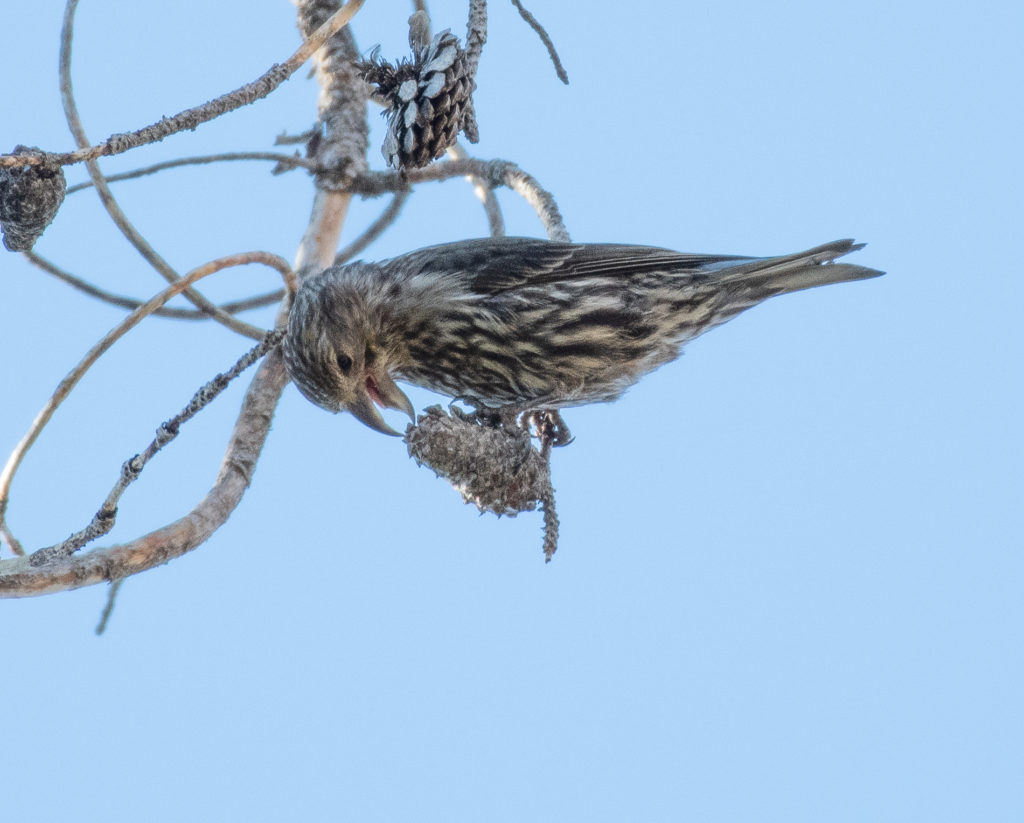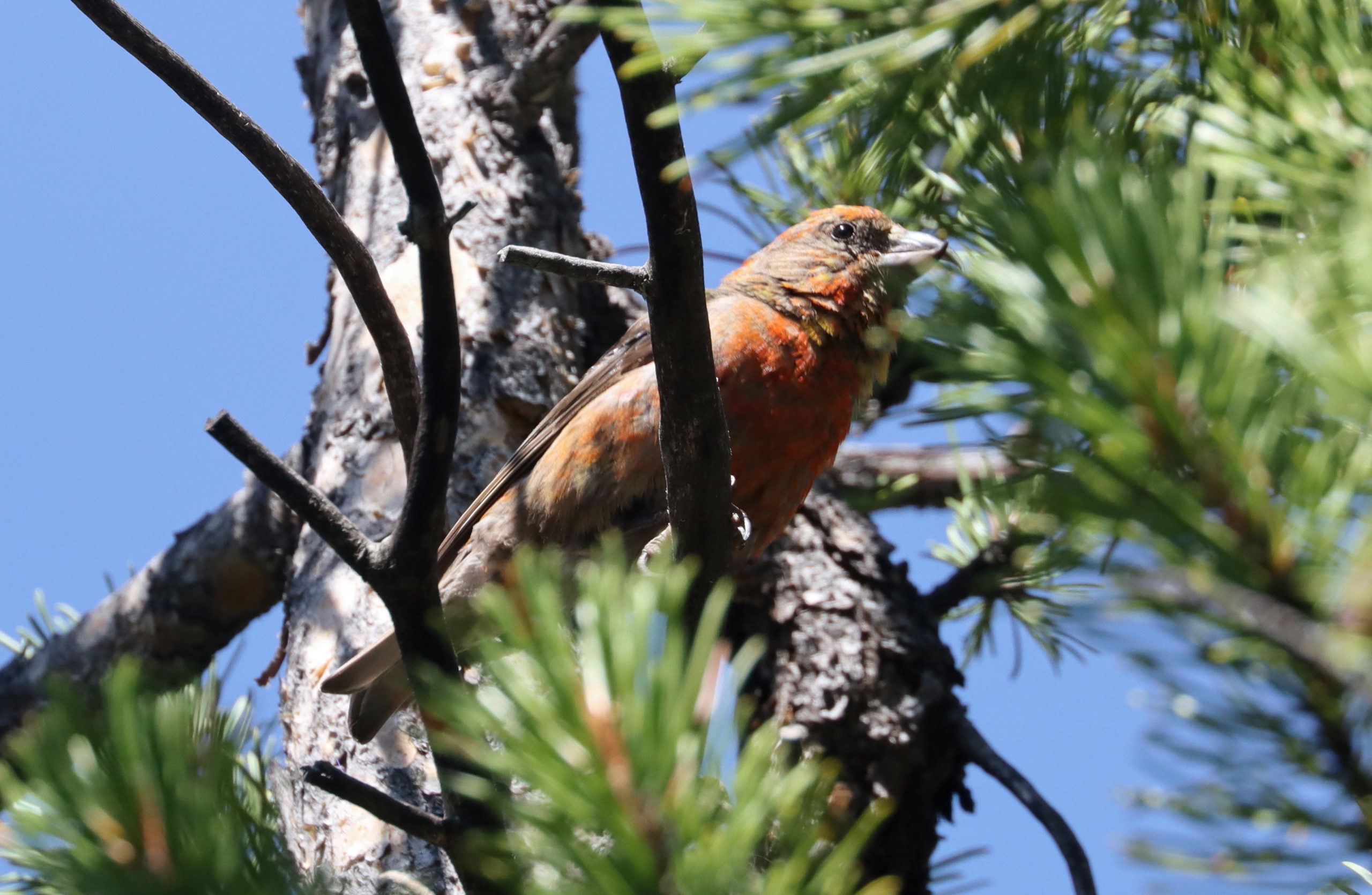Cassia Crossbills in Colorado — The Mystery Deepens:
By Nathan Pieplow —
A species or not?
In 2017, the so-called “Type 9 Red Crossbill” was split into a separate species, Cassia Crossbill, filling the birding community with both excitement and despair.
Listers had a new bird to chase, a localized endemic found exclusively in the isolated cluster of mountains just south of Twin Falls, Idaho. What better excuse to explore a new region of the country, well off the beaten track?
But some folks weren’t thrilled with the bird itself. Cassia Crossbill can’t be identified by any visual field mark – only by spectrographic analysis of its flight call. That doesn’t make for a very satisfying field experience. You might not be sure of your tick until you are back at home, and that opens up the potential nightmare scenario of finding out too late that you never had the bird at all. (While researching for this article, I flagged an eBird recording from the South Hills labeled “Cassia Crossbill” that was really a Type 5 Red Crossbill. I’m afraid I just wiped out somebody’s lifer.)
While crossbill flight calls are thought to be honest signals, to make matters more difficult, crossbills learn their flight calls, and a few (fewer than 1%) have been documented switching flight calls over the course of their lives. This means that on rare occasion a Cassia Crossbill might not be reliably identifiable by any known technique – not in the field, not in the hand, maybe not even in the lab – and that uncomfortable fact stretches most people’s notions of what a species actually is.
But the American Ornithological Society’s North American Checklist Committee maintains that Cassia Crossbill is indeed a separate species, on the basis of its distinct behavior (mostly sedentary), its different flight call, its mild but measurable genetic separation from Red Crossbill, and its apparent reproductive isolation (> 99% assortative mating).
With many years of research and a mountain of data from banded and recorded birds, Craig Benkman and his collaborators were able to tell the checklist committee a story that goes like this:
Cassia Crossbills don’t wander from forest to forest the way most Red Crossbills do. They stay in Cassia County, Idaho, using their slightly-larger-than-average bills to open the significantly-larger-than-average cones of the local Lodgepole Pines that have been supersized by evolution in the absence of seed-hungry squirrels. Although Type 5 and Type 2 Red Crossbills wander into the South Hills regularly, they rarely stay to breed, because those beefy cones are too big for their liking. When 5 and 2 do stay to breed, they tend to choose partners from their own call types, and so we see a pattern of assortative mating in sympatry — which means that if things continue as they are, Cassia and Red Crossbills will remain on separate evolutionary trajectories into the indefinite future. This is pretty much the gold standard for splitting a biological species. The vote to split was 8-2.
In 2022, the committee reaffirmed this decision, but only by a vote of 6-4. Two members reversed their votes from 2017, citing the potential fragility and reversibility of the factors keeping Cassia and Red Crossbills apart. For now, however, species status remains for Cassia Crossbills.
A belated first state record
But if spectrographic analysis can wipe Cassia Crossbills off your life list long after you get home, it can also make them appear where you never expected them.
That’s what happened to Christian Nunes. In July 2021, he recorded the crossbills around his campsite in Grand County, Colorado, intending to analyze the audio after he got home. He didn’t get around to it until November. (Note: I am so, so guilty of this exact mistake – it took me fourteen years to discover that I’d recorded a Type 3 Red Crossbill in Colorado in 2007!)
When Christian did analyze his recordings, he discovered, to his shock, that he’d documented Cassia Crossbills. This represented the first state record for Colorado, and the first record of Cassia Crossbill anywhere outside southern Idaho.
It seemed astonishing that a mostly sedentary species would show up so far from home. But as Christian pointed out, the South Hills of Idaho suffered an enormous wildfire in the summer of 2020. The boundaries of the Badger Fire encompassed nearly a third of the world’s habitat for Cassia Crossbills, so maybe the fire had pushed Cassia Crossbills out of Idaho for the first time.
It made some sense, then, when Luke Pheneger discovered Cassia Crossbills in Summit County in July of 2022, about twenty miles southwest of Christian’s initial sighting. If a sedentary species gets pushed out of its home range, wouldn’t it be more likely to stick around where it ends up? Luke’s recordings inspired dozens of birders to look (listen) for Colorado Cassia Crossbills in the following weeks, and many people managed to document them both where Luke found them and also in adjacent Eagle County and Park County. Interestingly, all confirmed observations in 2021 and 2022 came from within a 20-mile radius of Silverthorne, Colorado (since this published Cassia Crossbill has also been confirmed in Pitkin County as well). It even appeared that Cassia Crossbills had nested in the area.

An even more belated first state record
Now here’s just one more data point that doesn’t quite fit with the hypothesis about the Badger Fire.
A couple of weeks ago, I discovered a recording I had made in Silverthorne, Colorado, in March of 2012. You guessed it — it’s a Cassia Crossbill. (I have no great excuse for being ten years behind on uploading my recordings to eBird – although I am trying to catch up. If I upload a hundred recordings a week it will only take me another year.)
What to make of this ten-year-old record? My internet research didn’t pull up any sign of major fires in the South Hills in 2010 or 2011. So what brought that Cassia to Colorado, eight years before the Badger Fire? Did that bird or its descendants hang out in Summit County for a decade before being properly noticed? Or did the species leave and come back again?
Although I have no way to prove it, my money is on the here-all-decade option. Until recently, not many people have been recording crossbills in Summit and surrounding counties.
At least for a while this summer, that changed. And I hope people keep seeking out and recording crossbills in the region in the coming years. If Cassia Crossbills can be found in central Colorado, then why not Utah? Why not Wyoming? Why not other parts of Colorado? What if the Badger Fire really did push a number of Cassia Crossbills out of their usual haunt? Luckily, the best crossbill habitat inside the fire perimeter did not burn – so the impact of the Badger Fire on Cassia Crossbills hopefully won’t be as severe as was initially feared. But large parts of the southern Rockies haven’t been checked for Cassias, and who knows where some of them might be hanging out?
I’ve heard a few people speculate that the discovery of Cassia Crossbills in Colorado might cast doubt on the validity of the species. If they’re not actually sedentary, the thinking goes, then maybe the initial case for the split was faulty. Personally, I think it would take MANY more observations of Cassia Crossbills wandering across the west before we could call the species nomadic, and even then, the assortative mating in sympatry, the different flight calls, and the slight genetic differences would still support the split. Cassia Crossbill is here to stay, I believe – on the AOS checklist, and maybe even in Summit County, Colorado.
Cover Photo Credit John Drummond
Nathan Pieplow is the author of the Peterson Field Guide to Bird Sounds, published in two volumes, Eastern and Western. An avid bird sound recordist and videographer, he is the author of the bird sound blog Earbirding.com, a board member of the Bird Conservancy of the Rockies, an author of the Colorado Birding Trail, and former editor of the journal Colorado Birds. He teaches writing and rhetoric at the University of Colorado in Boulder.
If people are looking for a nice holiday present now that November is here, here’s a chance to get either the Winter Finch Forecast apparel or the Evening Grosbeak Road to Recovery apparel.
The Evening Grosbeak Road to Recovery Project is a collaboration of the Western Pennsylvania Conservancy’s Natural Heritage Program (PNHP), the Carnegie Museum of Natural History’s Powdermill Avian Research Center and The Finchmasters – Finch Research Network.
#birds #birding #conservation #tshirt
The Finch Research Network (FiRN) is a nonprofit, and has been granted 501c3 status. FiRN is committed to researching and protecting finch species like the Cassia Crossbill, Evening Grosbeak, finches of Hawaii (aka the honeycreepers) and more. The Evening Grosbeak has declined 92% since 1970. We are fundraising around an Evening Grosbeak Road to Recovery project in addition to a student research project, so please think about supporting our efforts and making a small donation at the donate link below.
Donate – FINCH RESEARCH NETWORK (finchnetwork.org)
We can also be found on FB, Instagram and Twitter at https://www.facebook.com/thefinchmasters and also on FB at Finches, Irruptions and Mast Crops.

